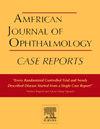摄入洗手液后双侧甲醇引起的视神经病变
Q3 Medicine
引用次数: 0
摘要
目的我们报告一例儿童双侧甲醇诱发的视神经病变,强调早期识别的重要性和可能的治疗选择。一名11岁女性,有自闭症谱系障碍(ASD)和异食癖病史,表现为数小时双侧“斑点”视力和头晕。在就诊前几小时,患者摄入了数量不详的召回洗手液。患儿视力正常,但扩张镜检查发现轻度双侧视盘水肿。光学相干断层扫描(OCT)显示双眼视网膜神经纤维层(RNFL)整体增厚。鉴于这些终末器官毒性的发现,患者紧急开始血液透析。结论及重要性:儿童ASD患者常伴有异食癖或回避/限制性食物摄入障碍(ARFID)等共病性饮食障碍。这类患者特别容易发生与限制营养摄入和有毒物质摄入有关的中毒性视神经病变。高度的临床怀疑和早期识别是及时治疗和视力恢复的关键。本文章由计算机程序翻译,如有差异,请以英文原文为准。
Bilateral methanol-induced optic neuropathy following hand sanitizer ingestion
Purpose
We report a case of a child with bilateral methanol-induced optic neuropathy highlighting the importance of early recognition and possible treatment options.
Observations
An 11-year-old female with history of autism spectrum disorder (ASD) and pica presented with a few hours of bilateral “spotty” vision and dizziness. Several hours prior to presentation, the patient ingested an unknown amount of recalled hand sanitizer. The child had normal vision, but dilated exam was notable for mild bilateral optic disc edema. Optical coherence tomography (OCT) of the retinal nerve fiber layer (RNFL) showed global thickening in both eyes. Given these findings of end-organ toxicity, the patient was urgently started on hemodialysis.
Conclusions and importance
Pediatric patients with ASD often have co-morbid eating disorders such as pica or avoidant/restrictive food intake disorder (ARFID). This population of patients is especially susceptible to toxic optic neuropathies related to restricted nutritional intake and toxic ingestion. A high clinical suspicion and early recognition is key to prompt treatment and visual recovery.
求助全文
通过发布文献求助,成功后即可免费获取论文全文。
去求助
来源期刊

American Journal of Ophthalmology Case Reports
Medicine-Ophthalmology
CiteScore
2.40
自引率
0.00%
发文量
513
审稿时长
16 weeks
期刊介绍:
The American Journal of Ophthalmology Case Reports is a peer-reviewed, scientific publication that welcomes the submission of original, previously unpublished case report manuscripts directed to ophthalmologists and visual science specialists. The cases shall be challenging and stimulating but shall also be presented in an educational format to engage the readers as if they are working alongside with the caring clinician scientists to manage the patients. Submissions shall be clear, concise, and well-documented reports. Brief reports and case series submissions on specific themes are also very welcome.
 求助内容:
求助内容: 应助结果提醒方式:
应助结果提醒方式:


